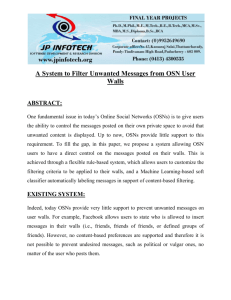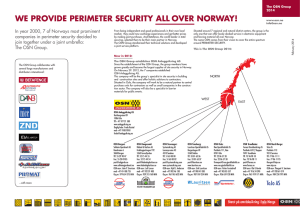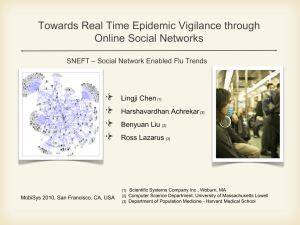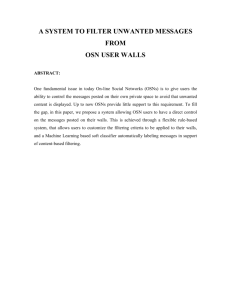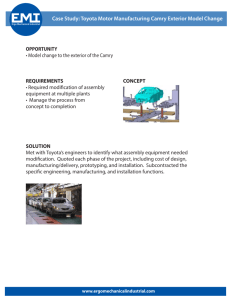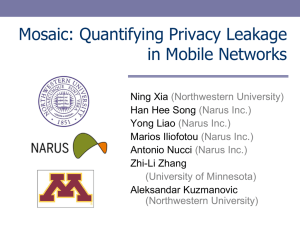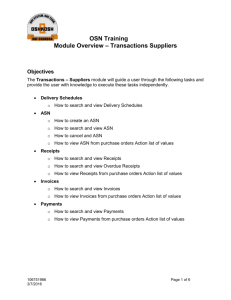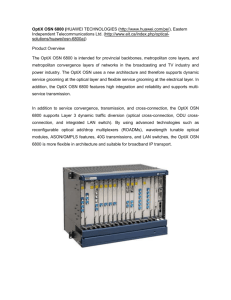Installation Guideline HD PVR
advertisement
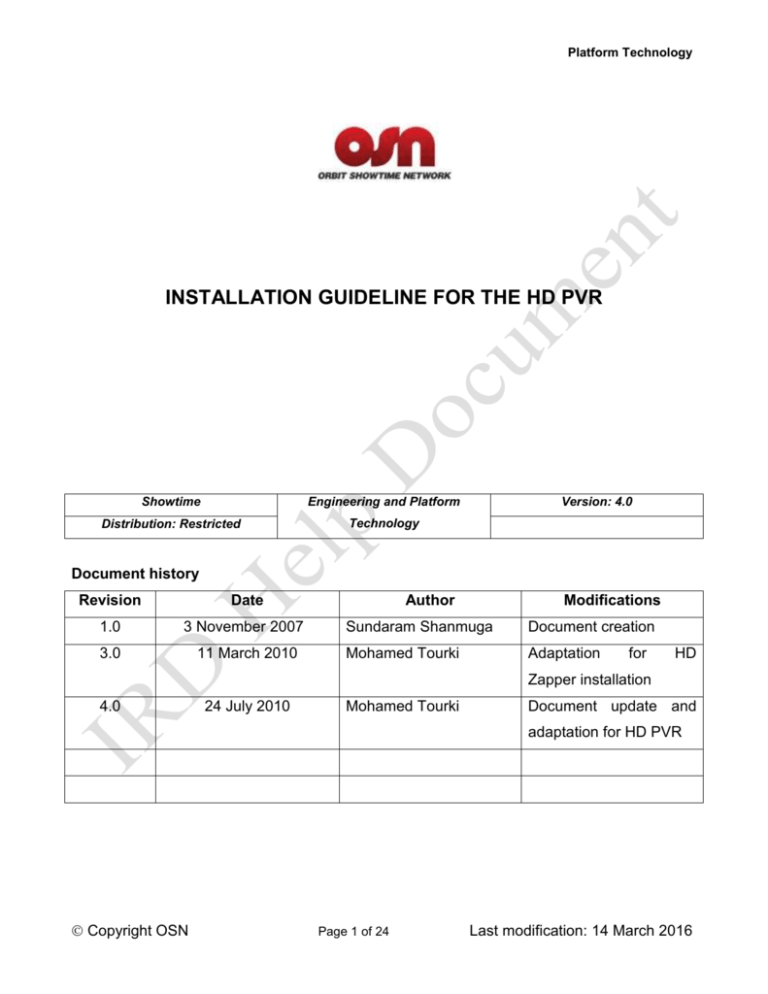
Platform Technology INSTALLATION GUIDELINE FOR THE HD PVR Showtime Engineering and Platform Distribution: Restricted Technology Version: 4.0 Document history Revision Date 1.0 3 November 2007 3.0 11 March 2010 Author Modifications Sundaram Shanmuga Document creation Mohamed Tourki Adaptation for HD Zapper installation 4.0 24 July 2010 Mohamed Tourki Document update and adaptation for HD PVR Copyright OSN Page 1 of 24 Last modification: 14 March 2016 Platform Technology INTRODUCTION ......................................................................................................................3 1. DTH NILESAT INSTALLATION ........................................................................................3 First time installation setup for the HD PVR ........................................................................................................................4 Universal LNB .........................................................................................................................................................................5 SATCR LNB ............................................................................................................................................................................5 2. DTH MULTISATELLITE INSTALLATION.........................................................................7 DiSEqC Requirements ............................................................................................................................................................7 LNB and DiSEqC setup ..........................................................................................................................................................8 FTA Scanned services .............................................................................................................................................................9 3. INSTALLATION IN AN MDU / BUILDING ......................................................................20 Amplifiers and Attenuators requirements...........................................................................................................................20 Multi-switch DC supply requirements .................................................................................................................................21 Cables requirements ..............................................................................................................................................................21 Test and Commissioning of the Installation ........................................................................................................................22 APPENDIX A – OSN TRANSPONDERS ON NILESAT ........................................................22 APPENDIX B – ACCESSORIES RECOMMENDATIONS .....................................................22 Dish Size for DTH customers: ..............................................................................................................................................22 Accessories for DTH installations: .......................................................................................................................................22 Accessories for MDU and distribution systems installations: ............................................................................................23 Copyright OSN Page 2 of 24 Last modification: 14 March 2016 Platform Technology Introduction This document explains in details the Installation Guidelines which needs to be followed while installing the OSN HD PVR. Any deviations from these recommendations may result in improper functioning / damage to the equipment. 1. DTH NILESAT INSTALLATION Position your dish, using whether a standard Universal LNB or the Legacy output of a SATCR LNB. SatCR LNB. Standard Universal or Legacy LNB. Copyright OSN Page 3 of 24 Last modification: 14 March 2016 Platform Technology First time installation setup for the HD PVR Booting Screen 1 Booting Screen 2 Menu Language Selection HD Resolution Selection Verify that the STB is having Nilesat feed connected Selection of the tuning parameters Copyright OSN Page 4 of 24 Last modification: 14 March 2016 Platform Technology Universal LNB The use of a twin a LNB is required to connect the OSN HD PVR two tuners. The leads are to be connected directly from the twin universal LNB to each one of the tuner connectors labelled SAT IN1 and SAT IN2 on the OSN HD PVR. Case of dual boxes installation HD PVR + HD Zapper A use of a Quattro LNB is advised in this case and a third cable should be run from the LNB to the second STB (HD Zapper). In case of multi-dishes installation (see correspondent section below) the cable should be run form the third output of the DiSEqC switch to the tuner input of the second STB (HD Zapper). SATCR LNB In case of SATCR LNB the use of all power pass splitter is required. The lead is to be connected directly from the SATCR LNB to the input of the all power pass splitter. The outputs of the splitter should be connected to each of the tuner connectors labelled SAT IN1 and SAT IN2 on the OSN HD PVR. Make sure that the below 4 user bands are available for each tuner input: - 1210 MHz - 1420 MHz - 1680 MHz - 2040 MHz And select two different user bands for each tuner and save the settings. Copyright OSN Page 5 of 24 Last modification: 14 March 2016 Platform Technology Case of dual boxes installation HD PVR + HD Zapper A use of a minimum three outputs of all power pass splitter is required. The lead is to be connected directly from the SATCR LNB to the input of the all power pass splitter. Two of the outputs of the splitter should be connected to each of the tuner connectors of the OSN HD PVR. While the third output should be connected to the input of the HD Zapper. Given that you already installed the HD PVR as per the previous picture settings. For the HD Zapper select a new user band than the one selected for the HD PVR. Notes: 1. DVB-S2: Due to the Phase Noise issues with legacy old LNBs, use of High gain Low Noise LNBs in edge of footprint is recommended. 2. Connect the STB to an HD TV using an HDMI cable. For a normal SD TV use an RCA/cinch cable to connect the TV and the STB in CVBS mode or Component mode. 3. For improved sound you can connect your receiver to a home cinema or Hi-Fi system using the receiver's DIGITAL AUDIO connectors. For this you will need a 75 ohm coaxial cable or a digital audio is compatible with Dolby Digital Plus. 4. Plug the fixed lead on the 12V power supply into the socket labelled DC 12V IN in the receiver. Plug the 2-way connector on the supplied mains lead into the socket on the 12V power supply unit. Connect the mains plug from the 12V power supply into a main wall socket. Copyright OSN Page 6 of 24 Last modification: 14 March 2016 Platform Technology Select a valid entry point (Transponder having valid SI) Once the tuning parameters are Signal level check correctly configured, the tuner is locked and the signal level is sufficient, press OK on the remote control. A screen as on the left-side will appear displaying a 1/4 video screen of the first service in Congratulations!! the Installation bouquet. succeeded. Select "Channel List" to view and browse the list of services. Installation succeeded 2. DTH MULTISATELLITE INSTALLATION DiSEqC Requirements This section will guide you through, how to setup the OSN HD PVR for multi-network configuration using DiSEqC switches. Let's take an example of an installation having 3 Networks: Nilesat, Hotbird and Arabsat, correspondingly configured on DiSEqC 1, DiSEqC 2, and DiSEqC 3. We require using a minimum of two DiSEqC switches to connect the OSN HD PVR. The output of the first Copyright OSN Page 7 of 24 Last modification: 14 March 2016 Platform Technology (corresp. the second) DiSEqC switch should be connected to the tuner number 1 (corresp. tuner number 2) connector labelled SAT IN 1 (corresp. SAT IN 2) of the OSN HD PVR. LNB and DiSEqC setup After the appropriate Outdoor Unit (ODU) installation has been done, the OSN HD PVR should be configured for all the three networks. This consists of matching the setup of the LNBs with the correspondent DiSEqC ports. By default settings is matching the above given installation example as per the illustration below. LNB 1 DiSEqC A is set for Nilesat LNB 2 DiSEqC C is set for Arabsat LNB 3 DiSEqC B is set for Hotbird Select a valid entry point (Transponder having valid SI) Copyright OSN Page 8 of 24 Last modification: 14 March 2016 Platform Technology Once the tuning parameters are correctly configured, the tuner is locked and the signal level is sufficient, press OK on the remote control. A screen as on the left-side will appear displaying a 1/4 video screen of the first service in Congratulations!! the Installation bouquet. succeeded. Select "Channel List" to view and browse the list of services. Signal level check Notes: The OSN HD services are broadcasted on the 10834 V and 11278 V frequencies with Baud rate of 27500 KSymbol/sec and FEC 2/3 (respectively 3/4). Hence having Low band Vertical frequencies is required to receive OSN HD services. The OSN HD IRD is not intended to be installed in Frequency Shifted IF buildings. This will be made available for next phase of software development. FTA Scanned services As in the OSN HD Zapper, the FTA (Free-to-Scanning) feature enable the user to scan other frequencies from different networks and store them in the services list subsequently to the default BAT service list. The networks can be on the same satellite as the home network or any other satellite. The Satellites available for the User to initiate the Free-To-Air Search are only those associated with an LNB each. The list has a maximum of four satellite names depending on the association of LNBs. The STB is able to scan and store more than 3000 services from different networks. The BAT services numbering range starts from 1 to 1000. Therefore the FTA scanned service numbering starts from 1001. Copyright OSN Page 9 of 24 Last modification: 14 March 2016 Platform Technology Steps to initiate a FTA (Free-to-Air) scanning After installation of the STB and assigning properly the different satellites to their correspondent DiSEqC ports perform the following steps as you can see in the pictures: Press Menu Select Free Scan Select Satellite Scan Select the satellite to be scanned Copyright OSN Page 10 of 24 Last modification: 14 March 2016 Platform Technology The scanning performed by the decoder is frequency based. Therefore for frequencies each is network a pre-programmed number with of their correspondent tuning parameters. However if a new frequency is introduced the user still able to enter manually the new frequency by selecting User defined transponder and editing the tuning parameters fields. Select All to scan FTA and scrambled services or only Free to Air Select User defined transponder Copyright OSN Enter the user frequency (e.g. 12283) Page 11 of 24 Last modification: 14 March 2016 Platform Technology Press green button to initiate an Automatic scan. This will go through all the preprogrammed frequency and the user entered frequency. Select the right Polarization, Symbol Rate and FEC A tick asset is placed by the TV services in the ‘TV Services’ vertical list and none on the Radio services. The tick asset indicates that the service is selected by default for be stored. TV and Radio Services are built up from the FTA Scanned Services Search. Copyright OSN Page 12 of 24 Last modification: 14 March 2016 Platform Technology Pressing the Right arrow key moves the highlight in sequence to the ‘Radio Services’ vertical list. Press OK button to select radio services. If the user selects ‘Add to Ch list’ the EPG stores all services that are given the tick asset at the end of the previous list. The EPG assigns automatically virtual channel numbers to the services starting from 1001 or last service number. If the user chooses the ‘Replace & Save’ button the EPG displays a Pop-up to warn the user that the operation will replace any existing stored services. Copyright OSN Page 13 of 24 Last modification: 14 March 2016 Platform Technology Pop up displayed during the storage of the new scanned serviced in the flash. If the user wants to enter one more frequency, then select again user and enter the new tuning parameters. Now select blue key to scan only the new entered frequency as the pre-programmed are already scanned previously. If the user selects ‘Add to Ch list’ the EPG stores all services that are given the tick asset at the end of the previous list. The EPG assigns automatically virtual channel numbers to the services starting from 1001 or last service number. Copyright OSN Page 14 of 24 Last modification: 14 March 2016 Platform Technology New FTA (Free-to-Air) scanned services stored in the list. Notes: While selecting Free to Air only free to air services will be scanned. The selection will be based on the setting implemented by the operator to define their services as FTA or CA scrambled. This is in conformance with DVB standards is done by setting the free_CA_mode in the SDT to 1 for scrambled service and to 0 for free to air service. Although, the DVB standards define this rule, some of the broadcasters especially on Hotbird are not following this rule. Therefore, even by selecting Free to Air, some scrambled services can be scanned. From the IRD perspective the scanning of these services is not avoidable, but we still able to delete these service if the user decide to do so. If a radio service is defined as a TV services by the broadcaster, then it will be listed along with TV services. Steps to initiate another network FTA (Free-to-Air) scanning The same steps a previously described have to be followed for any other network FTA service scanning. Copyright OSN Page 15 of 24 Last modification: 14 March 2016 Platform Technology LNB 3 DiSEqC B is set for Hotbird Copyright OSN Select a valid entry point (Transponder having valid SI) Page 16 of 24 Last modification: 14 March 2016 Platform Technology The installer should perform a site test at each location to determine that all the services provided are listed at the levels required for distribution (see below). Any service not found as a result of the site test must be reported immediately to OSN Platform Technology so that an agreement may be made as to which services will be provided to the customer. Steps to delete some of the FTA (Free-to-Air) scanned services Copyright OSN Page 17 of 24 Last modification: 14 March 2016 Platform Technology Copyright OSN Page 18 of 24 Last modification: 14 March 2016 Platform Technology Steps to delete all FTA (Free-to-Air) scanned services Deleting All services will delete all FTA scanned services. The service present in the bouquet list can not be deleted from the decoder. Notes: The current hardware version of the OSN HD PVR does not support Common-Interface (CI) slot/functionality. Therefore, the OSN HD PVR is to be used exclusively with OSN network services or Free-to-Air services. (The device cannot descramble third-party scrambled services). The OSN HD PVR has a restriction on scanning the third-party TV HD services declared as service type (0x19). Copyright OSN Page 19 of 24 Last modification: 14 March 2016 Platform Technology 3. INSTALLATION IN AN MDU / BUILDING All signal levels must comply with the maximum provided for by the amplifiers installed or to be installed taking into account adequate rating for the number of channels distributed and amplifiers in cascade The maximum/minimum levels at each outlet position on the system are as follows: MAXIMUM LEVEL Satellite IF 77 dBµV Digital MINIMUM LEVEL 52 dBµV The Satellite Digital frequencies require a minimum Carrier to Noise ratio at the outlets of 9 dB. Measurement of Carrier to Noise ratio should be made against a "noise floor" and not between transponders. The recommended frequencies to set the noise floor are 1,970 MHz. in the low band and 1,070 MHz. in the high band. Should a transponder signal be present at these frequencies than the "noise floor" frequency should be adjusted to avoid conflict. Dishes should be aligned for maximum signal strength and carrier to noise ratios. The LNB should be aligned so that the horizontal and vertical transponders appear equal and give maximum rejection of the opposite polarity, this is to avoid cross polarisation problems. Amplifiers and Attenuators requirements In case the signal is below 52 dBµV, use an amplifier but the amplified signal should not exceed 77 dBµV. In case the signal is above 77 dBµV, then use an attenuator or a splitter to reduce the signal level. All amplifiers and distribution equipment shall be by an OSN certified supplier, See appendix B for details. All Equipment must be able to cope with the minimum and maximum signal levels. Copyright OSN Page 20 of 24 Last modification: 14 March 2016 Platform Technology Multi-switch DC supply requirements If the multiswitches are line powered from the HD IRD only, and no other power supply is used, care must be taken to ensure that the maximum current drawn, including the LNB, is less than 315 mA. In case of using a Multi-switch, it should not have an insertion loss more than 4-6dB. In case of cascaded switch system, make sure that there is no return DC voltage from the switch to the HD IRD tuner. Cables requirements All cables shall be manufactured to the relevant parts of Specification EN 50117. All co-axial cables shall be sourced from an OSN certified supplier, see appendix B for details. RG-6 low loss coaxial cable should be used (Typical Loss 4-6 dB/100 m). All coaxial cable shall have a nominal characteristic of 75 ohms and will be suitable for the application concerned. Within the head-end and network, the connection of the coaxial cable will be via F-type and IEC connectors only. All F-connectors must be crimped and IEC connectors should be of a professional design and correctly made off. All connectors should be the correct size for the cable used. Avoid using cable jointers or passive splitters to join cables. It is recommended to use a single cable as much as possible without any joints / splits. In case of unavoidable situations where you need to use jointers it is advisable to use Line Amplifiers instead. All accessories must conform to the requirements of CENELEC EN 50083. All passive accessories will be 75 ohms. All satellite IF frequencies will be connected using Ftype connectors. External equipment will be housed in suitable waterproof enclosures. Copyright OSN Page 21 of 24 Last modification: 14 March 2016 Platform Technology Test and Commissioning of the Installation The installer has to supply a test and commissioning report, indicating signals at the inputs and output of the main equipment and levels received at the outlets. The installer will have to demonstrate to OSN that the picture quality on all the services stated is good. Test equipment must be accurate to within +/- 3dB and suitable for all the services indicated. The minimum requirement is a spectrum Analyser, a simple signal strength indicator is not sufficient. Appendix A – OSN Transponders on Nilesat Network Id: 2048 (0x800) FREQ (MHz) Polarity (H/V) Symbol Rate (Baud) FEC Transport Stream ID 11862 Vertical 27500 3/4 2 11996 Horizontal 27500 3/4 3 12073 Horizontal 27500 3/4 4 11977 Vertical 27500 5/6 20 11373 Horizontal 27500 3/4 45 11411 Horizontal 27500 3/4 46 11278 Vertical 27500 2/3 47 (HD) 10834 Vertical 27500 2/3 116 (HD) Appendix B – Accessories Recommendations Dish Size for DTH customers: As the EIRP of Atlantic Bird 4 (partially operated by Nilesat) in direction of UAE and Oman is low, it is recommended to use an offset dishes with a major axis of 110 cm. Accessories for DTH installations: Accessories Unicable LNB Copyright OSN Recommended Brand / Model Specifications Insertion loss Page 22 of 24 0.5 dB FTA Inverto, Zinwell Last modification: 14 March 2016 Platform Technology Insertion loss 3-4dB 4 way IF Splitter in Unicable DTH Isolation installations DiSEqC Switch in DTH installations Coaxial Cable in DTH installations 25 dB Triax, Ikusi type Power pass All Ports Insertion 2 dB loss Spaun SAR 411 25 to Teledis RESCH SDS 411 Isolation 30dB Teledis HCS41. Current max 500mA Type RG 6 Dielectric Foam Commscope, Televes, Conductor CCS Skylink 40% Braid 60% Accessories for MDU and distribution systems installations: Coaxial Cables Televes www.televes.com Commscope www.commscope.com Mains Powered Stand Alone Multiswitches Spaun www.spaun.de Fracarro www.fracarro.com Triax www.triax.com Global Communications www.globalcom.co.uk Copyright OSN Page 23 of 24 Last modification: 14 March 2016 Platform Technology Televes www.televes.com Ikusi www.ikusi.es Ankaro www.ankaro.de Cascadeable Multiswitch Ranges Spaun Standard Range + Penta Tap Range www.spaun.de Fracarro GII Range, XS Range, XS Plus Range www.fracarro.com Triax Districom 4000 Range + TMS Cascade Range www.triax.com Global Switchmaster Range www.globalcom.co.uk Kathrein Citicom Switch Range www.kathrein.com Ankaro www.ankaro.de Unicable cascadable Multiswitch Ranges Ankaro www.ankaro.de Copyright OSN Page 24 of 24 Last modification: 14 March 2016
